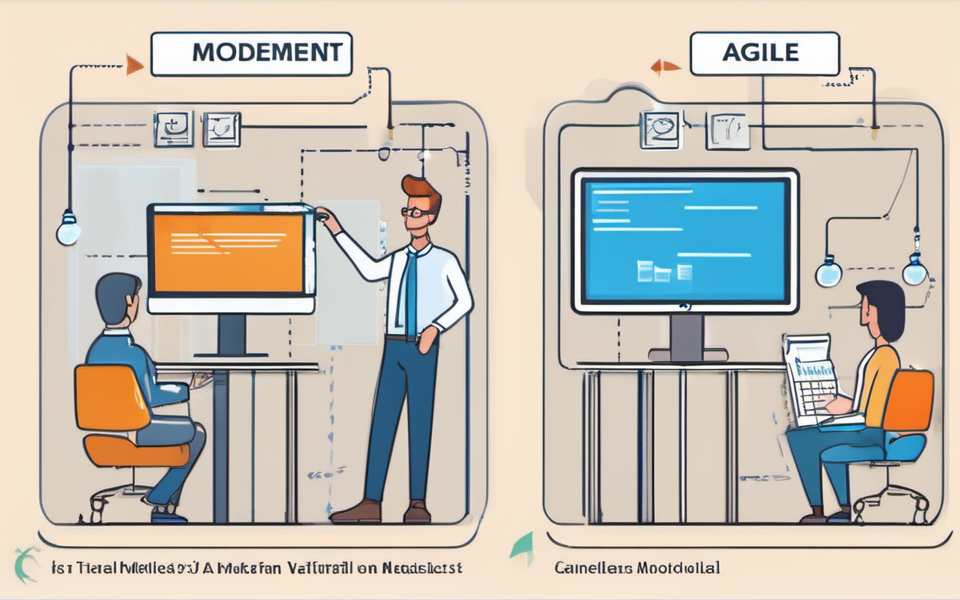Ever wondered why some software projects feel like a smooth ride while others seem like a never-ending rollercoaster? The secret lies in the methodology! Join me as we dive into the captivating world of Agile and Waterfall methodologies and find out which one reigns supreme!
Understanding Agile: The Fast and Flexible
Imagine you’re building a house but can tweak the design, add new rooms, or change the paint color anytime you want. That’s Agile for you! Agile is all about being flexible and adapting to changes quickly. It’s like having a team of builders who are ready to switch gears and fix issues on the fly.
Agile methodology breaks down the project into small chunks called “sprints.” Each sprint is like a mini-project that’s completed in a short time frame, usually 2-4 weeks. At the end of each sprint, the team reviews what they’ve built, gathers feedback, and makes necessary adjustments. This way, the project evolves and improves continuously, keeping the end user’s needs in focus.
Collaboration is Key
One of the shining stars of Agile is collaboration. The Agile team isn’t just made up of developers. It includes everyone from testers to project managers and even the customers. They work together closely, ensuring that everyone is on the same page. Regular meetings, known as “stand-ups,” help the team discuss progress, identify roadblocks, and find solutions promptly.
Quick Response to Change
In the rapidly changing tech world, what works today might not be good enough tomorrow. Agile shines here by allowing the team to respond to changes quickly. If a customer suddenly decides they want an extra feature or a different user interface, Agile has the flexibility to accommodate those changes without breaking a sweat.
This ability to pivot and adjust is what makes Agile so popular in industries like software development, where customer satisfaction and quick delivery are top priorities. However, it’s not just about speed and flexibility; Agile also emphasizes delivering high-quality products by regularly testing and refining the output.
The Waterfall Methodology: Structured and Sequential
Picture building a house with a detailed blueprint that you can’t change once you start construction. That’s Waterfall for you! Known for its structured approach, Waterfall is like following a recipe to the letter without deviating from the plan. Each phase of the project flows into the next, like water cascading down steps.
Waterfall methodology is divided into distinct phases: requirements, design, implementation, testing, deployment, and maintenance. Once a phase is completed, the team moves on to the next, with little room for revisiting previous stages.
Clear Documentation
One of the strengths of Waterfall is clear documentation. Each phase is meticulously documented, providing a clear roadmap for the project. This detailed documentation can be particularly useful for large projects where a lot of team members are involved and need to understand their specific tasks and responsibilities.
Predictability and Control
Waterfall’s structured approach offers predictability and control. Since the entire project is planned out in advance, it’s easier to estimate timelines and resource requirements. This makes Waterfall ideal for projects with well-defined requirements that are unlikely to change.
However, this rigidity can be a downside if unexpected changes occur. Since Waterfall doesn’t easily accommodate changes once a phase is completed, any deviation from the plan can lead to delays and increased costs. This lack of flexibility often means that Waterfall is less suited to dynamic, fast-paced environments where requirements frequently evolve.
Which Methodology Should You Choose?
So, Agile or Waterfall? The choice largely depends on the nature of your project, the team, and the industry you’re working in. Both methodologies have their pros and cons, and sometimes even a hybrid approach might be the best solution.
If you need a flexible approach that allows for continuous improvement and quick response to changes, Agile is your go-to. It’s perfect for projects where customer feedback and collaboration are crucial. On the other hand, if your project has well-defined requirements and you value predictability and control, Waterfall might be the better option.
Conclusion
In the end, both Agile and Waterfall methodologies offer unique benefits. The key is to understand the specific needs of your project and choose the methodology that aligns best with your goals. Whether you prefer the fast-paced, adaptive nature of Agile or the structured, predictable environment of Waterfall, success lies in effectively applying the chosen methodology to deliver the best possible results.




